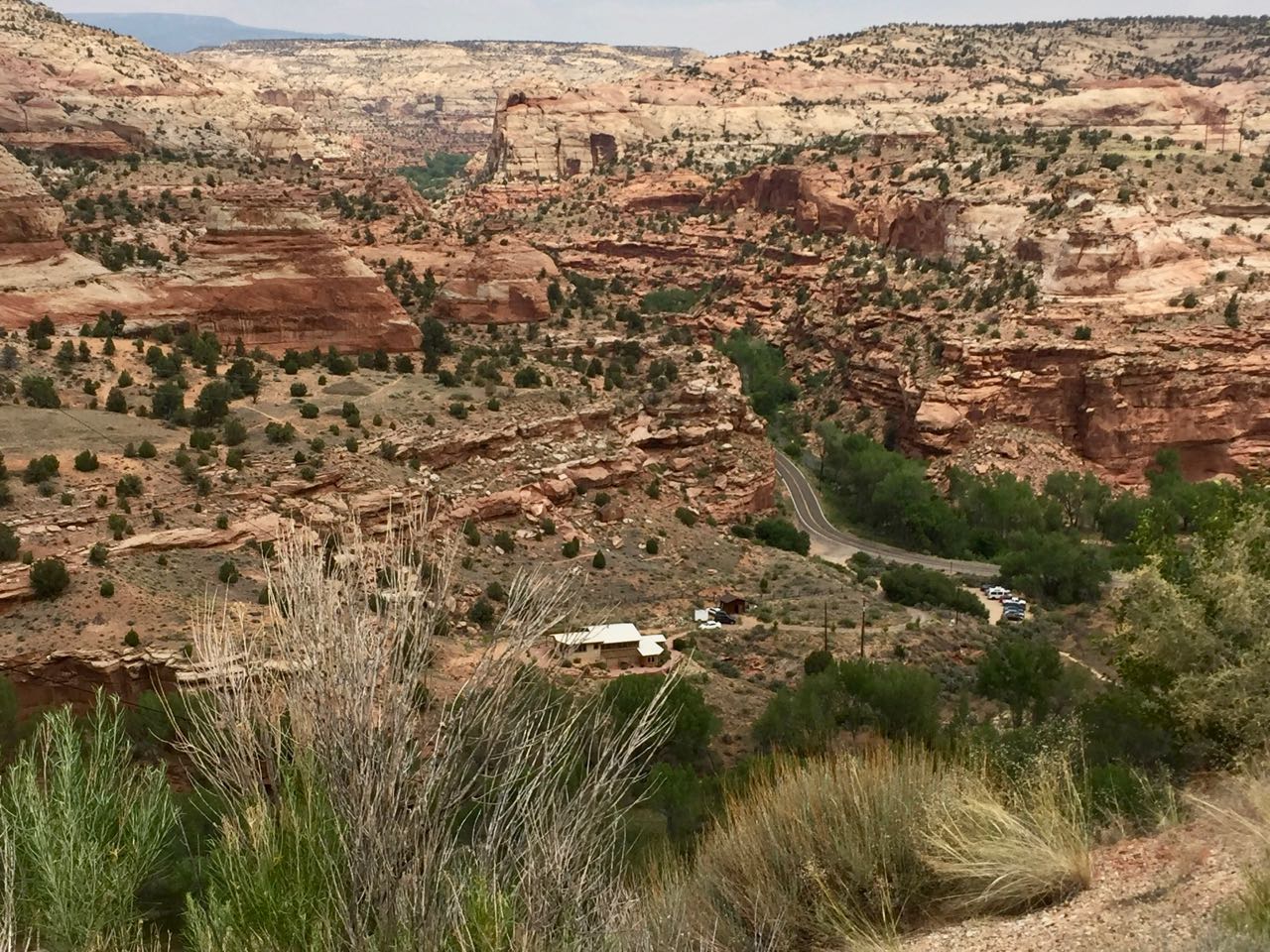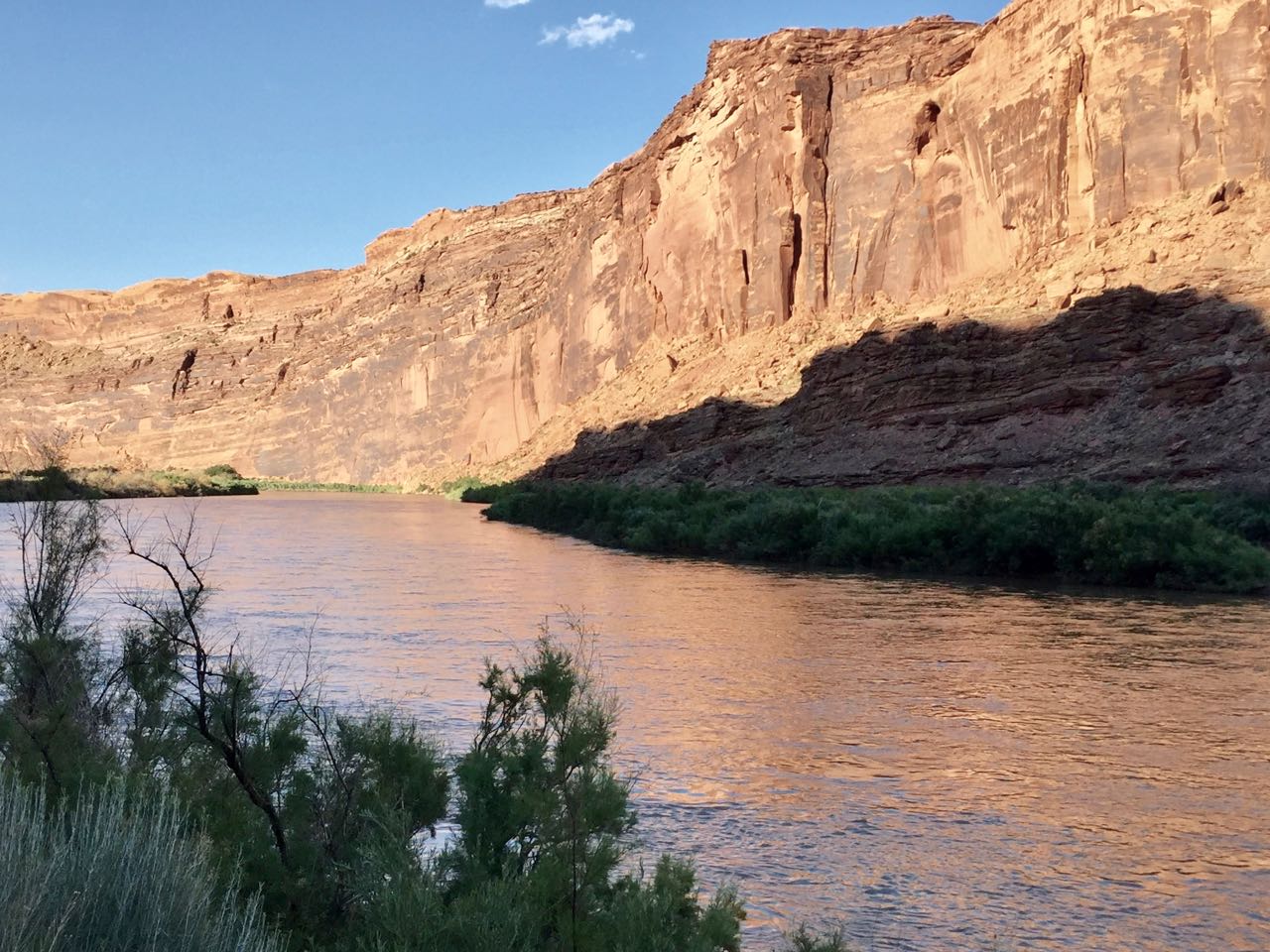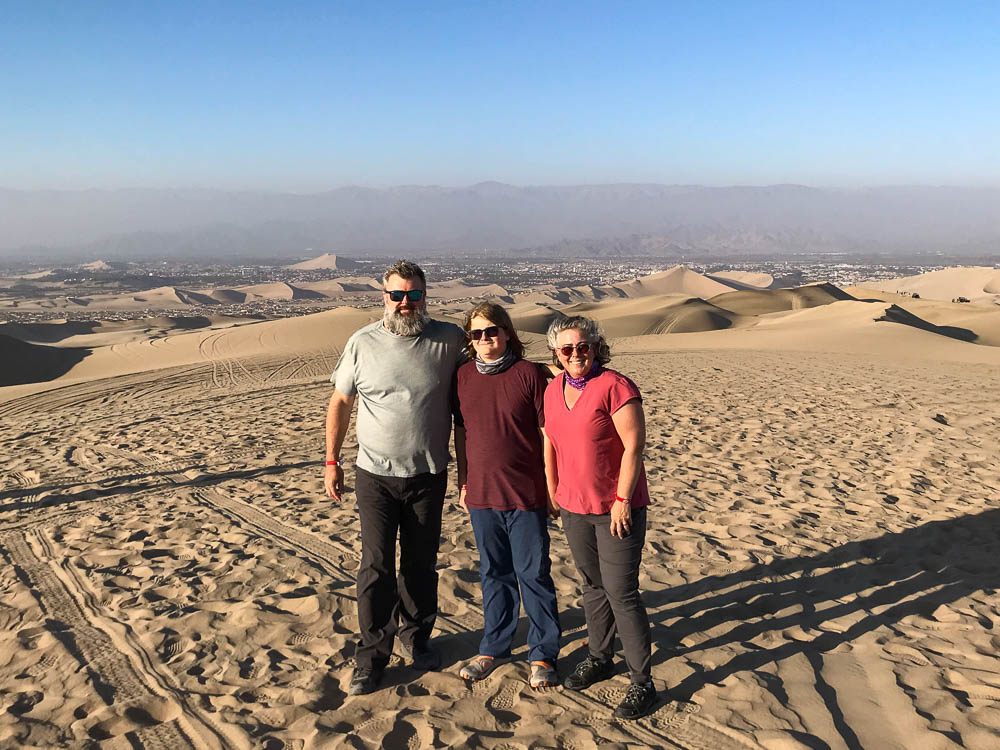Summer Road Trip – Capitol Reef National Park
After Zion and Bryce Canyon, Capitol Reef National Park was our next stop. This is the least-visited of Utah’s national parks. However it is well worth a visit, with some interesting historic attractions to go with the usual geological wonders.
Introduction to Capitol Reef National Park
It was another hot summer day in Utah, so we got moving early in the morning on the one full day we planned to be in the park. As soon as we crossed into the park we encountered some quality scenery worthy of the National Park designation. We stopped at the aptly named Panorama Point to get our first good look.

Capitol Reef National Park
Our next stop was the Visitor Center, which nestles beneath a photogenic rock formation. The friendly rangers gave us some good information about the park and which hikes would suit our (lack of) fitness level. They pointed us in the direction of the park’s Scenic Drive. At the end of this drive is the trailhead for the Capitol Gorge Trail, which would be our hike for the morning.

Capitol Reef National Park Visitor Center
Capitol Gorge Trail
After parking our car near the Capitol Gorge trailhead we put on our sunscreens, hats and hydration packs and set off into the gorge.

Hiking Capitol Gorge, Capitol Reef National Park
This is a fascinating walk, with lots of history, as well as spectacular scenery. The first point of interest we came to was some 1,000 year old Fremont petroglyphs.

Petroglyphs, Capital Gorge, Capitol Reef National Park
For many years, this was the only way through the barrier-like rock formation known as the Waterpocket Fold. In fact it wasn’t until Utah Highway 24 was built in 1962 that Capital Gorge was closed to vehicular traffic. In the late 19th century, the traffic was horse-drawn. The Mormon pioneers left their mark, inscribing their names and dates of passage on the canyon walls in the area known as the Pioneer Register.

Pioneer Register, graffiti left by Mormon pioneers, Capitol Gorge, Capitol Reef National Park
The trail continues, a fairly easy hike along a sandy wash between steep canyon walls on either side.

Hiking Capitol Gorge, Capitol Reef National Park
About a mile into the hike we reached a short (but steep) trail up to some natural water pools that were very convenient for the early settlers moving into the area to replenish their water supplies as they travelled.

Hiking to the Tanks, Capitol Gorge, Capitol Reef National Park

Tanks (natural water pockets), Capitol Gorge Trail, Capitol Reef National Park
After the climb up to the tanks and back down into the gorge, we headed back down the trail to the car. The return was a bit of a hard slog, with the heat of the day increasing. We were glad to make it back to car and turn the air conditioning back on for the drive back down the Scenic Drive.
Fruita Historic District
After our morning’s hiking exertions, we headed to historic Fruita district we’d passed though on the way to Capital Gorge. The lush green lawn and shade trees next to the Fremont River provide a place to rest up and have a picnic lunch. There is no restaurant in Capitol Reef National Park, so we made do with some home-made pie from the store at the Gifford Homestead. You can buy hand-crafted items and rustic souvenirs as well as pies and home made ice cream treats. There are a number of historic orchards in the area under management of the National Park Service where you can sample the fruit in season.

Fruita, Capitol Reef National Park
Capital Dome and Beyond
We had thought that we might hike another of the park’s trails after lunch, but with the summer heat and our tired legs we decided to do a driving tour instead. Our first stop was to check out Capital Dome, the most impressive of the dome formations that gives the park its name.

Capitol Dome, Capitol Reef National Park
We then headed east outside the park boundaries to explore some back roads. This let gave us the chance to see a bit more of Utah outside the national parks. We came across a historical marker that told a story of a small, close-knit community that had eked out an existence here under trying conditions.

Just Outside Capitol Reef National Park
Stargazing in Capitol Reef National Park
Utah in general, and Capitol Reef National Park in particular is a great place to do some stargazing. So far on our Utah road trip the moon had been full or close to each night. This gave us the chance to do an awesome full moon hike while we were in Bryce Canyon National Park, but we also wanted to see some stars. Lachlan has grown up in the city surrounded by light pollution, so doesn’t see many stars in his everyday life. Heide and I have memories of star-filled skies from growing up in Montana and Australia, so we were hoping that Lachlan would get the chance to do some stargazing.
Checking the moonrise on the chart at the park visitors center, it looked like there was some time between sunset and moonrise that would provide an opportunity to see a sky full of stars. Talking to Lachlan, we realized that he had never seen the Milky Way, which we intended to remedy. After dinner we headed back into the park to Panorama Point.
Before the stars came out we enjoyed a lengthy sunset and twilight. At least we enjoyed it for a while, then got tired while waiting for the stars to show up. It had been a long day.

Sunset, Capitol Reef National Park
Unfortunately, I didn’t have the right camera equipment with me to capture the stars when they eventually showed up, but you can check out this page to see what we saw. We achieved our goal of seeing the Milky Way and a multitude of stars over Capitol Reef National Park. Then we headed back to our hotel where we slept very well after our long day.
Where to Stay and Eat Near Capitol Reef National Park
There is no lodge in the park, so if you want to stay in the park you need to camp. The campground is very conveniently located in the historic Fruita area, right next to the park’s Scenic Drive.
For a solid roof over your head, there are options in the nearby town of Torrey. We stayed at the Capitol Reef Resort, just a mile from the park boundary. We chose a traditional style hotel room, which was quite comfortable. There are also cabins, tepees and even Conestoga wagons for more adventurous options. As Capitol Reef National Park sees fewer visitors than other Utah national parks, the accommodation rates tend to be lower. There are couple of motels are the most budget-friendly options, or you can go for a bed and breakfast for a more deluxe experience.
The resort’s restaurant served a decent breakfast, but we chose to go elsewhere for dinner. The night we arrived in Torrey we ate at the Capitol Reef Inn & Cafe. Like the Hell’s Backbone Grill on the drive from Bryce Canyon, it serves healthy local food. The next night we went for old-school burgers, fries and shakes at Slackers Burger Joint, which hit the spot after our morning hike and fruit pie lunch left us needing a hearty dinner.
If you are headed to Moab after Capital Reef like we were, the Mesa Farm Market is worth a stop. It’s about twenty miles east of the national park, pretty much in the middle of nowhere. They sell organic produce and artisanal bread, as well as cheese from the goats that they raise sustainably on site. It’s the sort of place you would expect to find in a hipster enclave, not in the wilds of Utah.
We would definitely go back to Capitol Reef National Park. We would like to hike some more of the trails, and maybe pick some fruit next time. Some of the areas that we didn’t get to (like Cathedral Valley) require a high clearance vehicle to access. The downsides of less development in the park (lack of restaurants and lodging in the park) are offset by the lack of crowds. It’s a more low-key experience, but definitely a worthwhile addition to a Utah road trip itinerary.




















 Travel Magazine
Travel Magazine